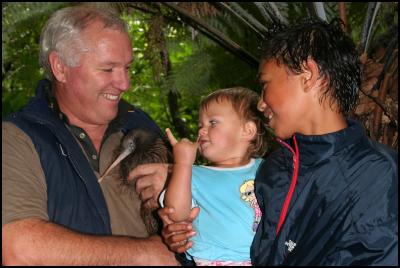Kiwi fly conservation-class to new home in Te Puke
15 March, 2007
Kiwi fly conservation-class to
new home in Te Puke

Two North Island brown kiwi found out what it felt like to fly yesterday (14 March), after boarding a plane in Christchurch and landing in Rotorua to be escorted to their new home in Te Puke.
The two kiwi, named Whetu and Maui, were raised as part of a national captive rearing programme at Willowbank Wildlife Reserve. They are the first North Island brown kiwi to be reintroduced into Otanewainuku forest in Te Puke after four years of joint preparation by the Otanewainuku Kiwi Trust and the Department of Conservation.
Mark Dean, chairman of the Trust, said he was excited to see a happy ending to all the hard work put in by volunteers.
“This is a great milestone for us. Our volunteers have spent thousands of hours removing pests and predators from more than 1000 hectares of untouched native forest in order to prepare the environment for a safe and successful kiwi release.”
The Trust, along with local iwi, DoC staff, and representatives from sponsoring companies celebrated the arrival of the kiwi by holding a small ceremony to introduce the birds to their new home and mark a memorable day.
The ceremony also kicked off the Trust’s new fundraising campaign for the building of a predator proof crèche, which is designed to protect kiwi chicks before their eventual release back into the forest.
Dave Wills, a DoC worker and member of the Trust drove the kiwi from Rotorua airport to their new home.
“It is so rewarding to see kiwi, our national icon, being reintroduced into the forest and to know that they will be protected. It is a special and humbling experience for all involved,” he said.
Whetu and Maui will be monitored closely by DoC staff through small radio tracking devices attached to their ankles and will be encouraged to breed in order to repopulate the area.
The multi award-winning Otanewainuku Kiwi Trust was formed in 2001 to undertake pest control for the existing kiwi population and allow successful breeding and reintroduction.
ENDS


 Gaurav Mittal, IMI: How Can We Balance AI’s Potential And Ethical Challenges?
Gaurav Mittal, IMI: How Can We Balance AI’s Potential And Ethical Challenges? Science Media Centre: Several US-based Environmental Science Databases To Be Taken Down – Expert Reaction
Science Media Centre: Several US-based Environmental Science Databases To Be Taken Down – Expert Reaction Consumer NZ: Despite Low Confidence In Government Efforts, People Want Urgent Action To Lower Grocery Bills
Consumer NZ: Despite Low Confidence In Government Efforts, People Want Urgent Action To Lower Grocery Bills NZ Banking Association: Banks Step Up Customer Scam Protections And Compensation
NZ Banking Association: Banks Step Up Customer Scam Protections And Compensation The Reserve Bank of New Zealand: CoFR Seeking Feedback On Access To Basic Transaction Accounts
The Reserve Bank of New Zealand: CoFR Seeking Feedback On Access To Basic Transaction Accounts 2Degrees: Stop The Pings - Half Of Kiwis Overwhelmed By Notifications
2Degrees: Stop The Pings - Half Of Kiwis Overwhelmed By Notifications



